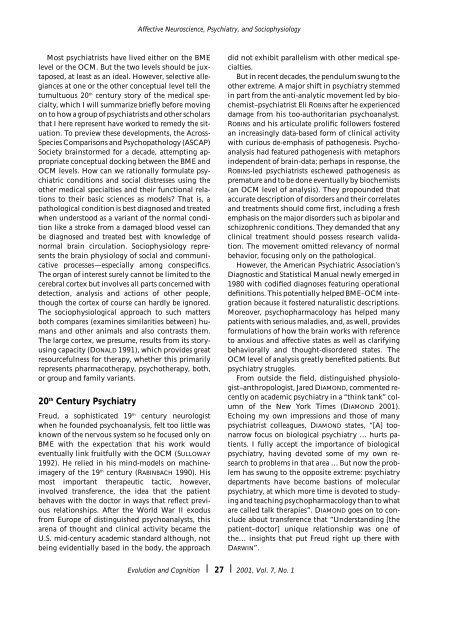The Seven Sins of Evolutionary Psychology - Konrad Lorenz Institute
The Seven Sins of Evolutionary Psychology - Konrad Lorenz Institute
The Seven Sins of Evolutionary Psychology - Konrad Lorenz Institute
You also want an ePaper? Increase the reach of your titles
YUMPU automatically turns print PDFs into web optimized ePapers that Google loves.
Affective Neuroscience, Psychiatry, and SociophysiologyMost psychiatrists have lived either on the BMElevel or the OCM. But the two levels should be juxtaposed,at least as an ideal. However, selective allegiancesat one or the other conceptual level tell thetumultuous 20 th century story <strong>of</strong> the medical specialty,which I will summarize briefly before movingon to how a group <strong>of</strong> psychiatrists and other scholarsthat I here represent have worked to remedy the situation.To preview these developments, the Across-Species Comparisons and Psychopathology (ASCAP)Society brainstormed for a decade, attempting appropriateconceptual docking between the BME andOCM levels. How can we rationally formulate psychiatricconditions and social distresses using theother medical specialties and their functional relationsto their basic sciences as models? That is, apathological condition is best diagnosed and treatedwhen understood as a variant <strong>of</strong> the normal conditionlike a stroke from a damaged blood vessel canbe diagnosed and treated best with knowledge <strong>of</strong>normal brain circulation. Sociophysiology representsthe brain physiology <strong>of</strong> social and communicativeprocesses—especially among conspecifics.<strong>The</strong> organ <strong>of</strong> interest surely cannot be limited to thecerebral cortex but involves all parts concerned withdetection, analysis and actions <strong>of</strong> other people,though the cortex <strong>of</strong> course can hardly be ignored.<strong>The</strong> sociophysiological approach to such mattersboth compares (examines similarities between) humansand other animals and also contrasts them.<strong>The</strong> large cortex, we presume, results from its storyusingcapacity (DONALD 1991), which provides greatresourcefulness for therapy, whether this primarilyrepresents pharmacotherapy, psychotherapy, both,or group and family variants.20 th Century PsychiatryFreud, a sophisticated 19 th century neurologistwhen he founded psychoanalysis, felt too little wasknown <strong>of</strong> the nervous system so he focused only onBME with the expectation that his work wouldeventually link fruitfully with the OCM (SULLOWAY1992). He relied in his mind-models on machineimagery<strong>of</strong> the 19 th century (RABINBACH 1990). Hismost important therapeutic tactic, however,involved transference, the idea that the patientbehaves with the doctor in ways that reflect previousrelationships. After the World War II exodusfrom Europe <strong>of</strong> distinguished psychoanalysts, thisarena <strong>of</strong> thought and clinical activity became theU.S. mid-century academic standard although, notbeing evidentially based in the body, the approachdid not exhibit parallelism with other medical specialties.But in recent decades, the pendulum swung to theother extreme. A major shift in psychiatry stemmedin part from the anti-analytic movement led by biochemist–psychiatristEli ROBINS after he experienceddamage from his too-authoritarian psychoanalyst.ROBINS and his articulate prolific followers fosteredan increasingly data-based form <strong>of</strong> clinical activitywith curious de-emphasis <strong>of</strong> pathogenesis. Psychoanalysishad featured pathogenesis with metaphorsindependent <strong>of</strong> brain-data; perhaps in response, theROBINS-led psychiatrists eschewed pathogenesis aspremature and to be done eventually by biochemists(an OCM level <strong>of</strong> analysis). <strong>The</strong>y propounded thataccurate description <strong>of</strong> disorders and their correlatesand treatments should come first, including a freshemphasis on the major disorders such as bipolar andschizophrenic conditions. <strong>The</strong>y demanded that anyclinical treatment should possess research validation.<strong>The</strong> movement omitted relevancy <strong>of</strong> normalbehavior, focusing only on the pathological.However, the American Psychiatric Association’sDiagnostic and Statistical Manual newly emerged in1980 with codified diagnoses featuring operationaldefinitions. This potentially helped BME–OCM integrationbecause it fostered naturalistic descriptions.Moreover, psychopharmacology has helped manypatients with serious maladies, and, as well, providesformulations <strong>of</strong> how the brain works with referenceto anxious and affective states as well as clarifyingbehaviorally and thought-disordered states. <strong>The</strong>OCM level <strong>of</strong> analysis greatly benefited patients. Butpsychiatry struggles.From outside the field, distinguished physiologist–anthropologist,Jared DIAMOND, commented recentlyon academic psychiatry in a “think tank” column<strong>of</strong> the New York Times (DIAMOND 2001).Echoing my own impressions and those <strong>of</strong> manypsychiatrist colleagues, DIAMOND states, “[A] toonarrowfocus on biological psychiatry … hurts patients.I fully accept the importance <strong>of</strong> biologicalpsychiatry, having devoted some <strong>of</strong> my own researchto problems in that area … But now the problemhas swung to the opposite extreme: psychiatrydepartments have become bastions <strong>of</strong> molecularpsychiatry, at which more time is devoted to studyingand teaching psychopharmacology than to whatare called talk therapies”. DIAMOND goes on to concludeabout transference that “Understanding [thepatient–doctor] unique relationship was one <strong>of</strong>the… insights that put Freud right up there withDARWIN”.Evolution and Cognition ❘ 27 ❘ 2001, Vol. 7, No. 1








